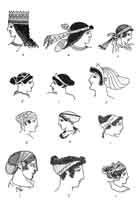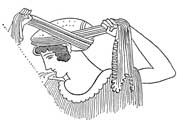Die griechische Kleidung - von der Sandale bis zur Kopfbedeckung
To one commending an orator for his skill in amplifying petty matters, Agesilaus said, “I do not think that shoemaker a good workman that makes a great shoe for a little foot.” Plutarch
Footwear of Ancient Greeks
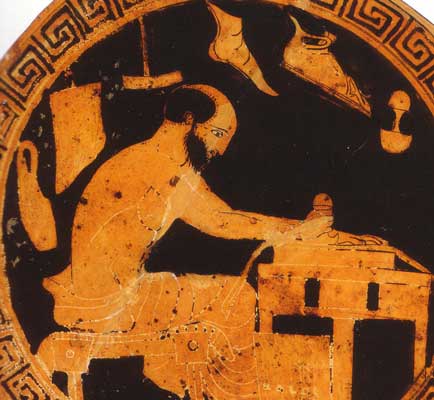
A shoemaker with an arbelos cutting leather for shoes. The Greek word: o (a)/rbhlos [the arbelos; of masc. gender] means the knife of the shoemaker (h is used for the symbol eta) . From the same stem arb- we have also: h (a)rbu/lh [of fem. Gender] : a kind of shoes (half-boot; like soldier's half-boot). This word survives in modern Greek but in its Doric form, that is, with the ending alpha (a) instead of eta (h) : h (a)rbu/la Antreas P. Hatzipolakis
See: http://www.vannacalzature.it/Storia_inglese/greci_inglese.htm
Askerai, Attic footwear Ἀσκέραι: ὑποδήματα Ἀττικά. . A winter shoe with fur lining
Cothurnus a leather boot with high soles to give them extra height (theater, actors). According to Webster from "the first certain picture of tragedy [on] an Attic oenoche painted about 470 BC," we can conclude that male characters in tragedy were distinguished from females by wearing "laced boots instead of loose-fitting boots". Webster, T.B.L., Greek Theatre Production. London: Methuen & Co. Ltd., 1970 p.38
Embades - an enclosed boot; from embainein ( to step into )
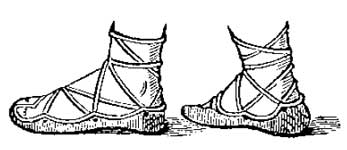
Karbatinai, shoes of undressed hide, brogues, made of a single piece of oxhide, so that sole and upper leather were all in one, and tied on with thongs. These shoes were so simple that they could be made easily, and so we find the Greek in the Anabasis resorting to them in an emergency. (White and Morgan, illustrated dictionary of Xenophon's Anabasis)
Krepis, Κρηπίς , Foundation, or a kind of shoe; a base , that which holds the feet (θεμέλιος, ἢ εἶδος ὑποδήματος: ὑποβάθρα. ἡ τοὺς πόδας κρατοῦσα.)
Talaria (Winged Sandals of Hermes)

Construction of shoes for a young Greek boy.
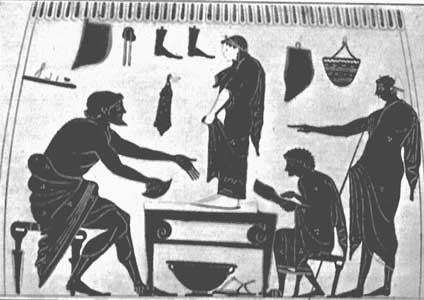
Shoe Shop, Boston Museum of Fine Arts

xample of footwear (here of Artemis) with complex decoration from a Pergamum sculpture.
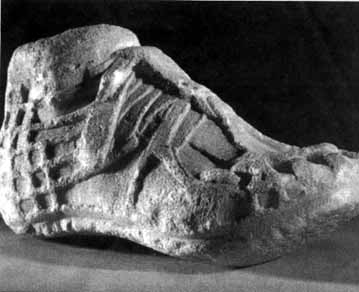

Shoes (c. 400 BC) and Nike shoes today (Images from http://www.kzu.ch/fach/as/gallerie/rare/shoes/shoe.htm) The Nike shoes symbol “The Nike Swoosh” according to various sources is a representation of a wing (probably of the Nike of Samothrace)

Artemis Rospigliosi Louvre Ma559 (Roman Copy of Greek Original)
Perseus - Image of Hermes Shoes with Wings! (Website sometimes offline)
Nike (Victory) Adjusting Her Sandal, fragment of the parapet (Kallikrates. Temple of Athenea Nike, Acropolis, Athens c. 425 BC)
According to Aelian, Philetas of Kos (born c. 340 BC, a poet) was so thin that he had to wear weights on his shoes to stop himself blown away by the wind.
Empedocles used to wear bronze sandals, one of these according to a legend was found at the Aetna mountain where it was reported that he leapt down into the vulcano crater.
Young Spartans did not use shoes and slaves usually were not allowed. There must be different type of shoes as Laoconian, Cretan, Milesian and Athenian shoes are mentioned or types introduces by some such as the shoes of Alcibiades, even today little seems to be known how they all looked.
Katherine Ely Dohan, Hypodemata: The study of Greek footwear and its chronological value, Bryn Mawr Dissertations 1982
Hairstyle

Barber cutting hair
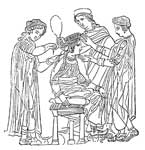

Click image to enlarge
Lycurgus the Lacedaemonian brought long hair into fashion among his countrymen, saying that it rendered those that were handsome more beautiful, and those that were deformed more terrible. Plutarch, Apophthegms of Kings and Great Commanders.
1500 - 650 BC Greek women had mostly long curly hair.
500 - 300 BC hair joined together to a knot at the neck (the Greek knot)
I see some women dye their hair blonde by using saffron. They are even ashamed of their country, sorry that they were not born in Germany or in Gaul! Tertullian (Quintus Septimius Florens T., c.150-230 AD) THE APPAREL OF WOMEN . With respect to the colour of the hair, black was the most frequent, but blonde xanthi kome was the most prized. In Homer, Achilles, Ulysses, and other heroes are represented with blonde hair (Il. i.197, Od. xiii.399, &c.). At a later time it seems to have been not unfrequent to dye hair, so as to make it either black or blonde, and this was done by men as well as women, especially when the hair was growing gray (Pollux, ii.35; Aelian, V.H. vii.20; Athen. xii p542d; Lucian, Amor. 40). William Smith
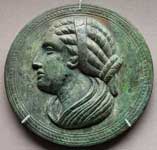
300 - 150 BC Hair color changed (lighten) using saffron (a method used for some centuries)
A little girl wears her hair pulled back in a lobed, braided hairstyle called a melon coiffure
A hairstyle around 50-25 BC with Cleopatra as a model (Cleopatra)
1st Century AD See: Paul and Corinthian Women's Hairstyles
Example Pottery Images: Artemis , Athena , Aphrodite , Cassandra , Demeter , Helen , Hera ,Medea , Nike , Sappho
Example Aphrodite (Bartlett Head) Late Classical or Early Hellenistic Period about 330–300 BC : Front , Left , Back , Right
Example of Statues: 460 BC Poseidon or Zeus from Artemision , Apollo in the Olympia Zeus Temple
In Euripides' play, Orestes assumes that Electra is a slave when he sees her approaching because of her cropped head and, presumably, her poor dress. She too talks about self-mutilation ('tearing my own throat with my nails and striking my shorn head with my hand'). When the Choruswomen enter to invite her to the temple of Hera, Electra points out that she can't go because she simply has nothing decent to wear, and, moreover, her hair needs washing. (Complex Electra)
Ampyx, (a kind of jewelry) called by the Romans frontale, was a broad band or plate of metal, which Greek ladies of rank wore upon the forehead as part of the head-dress (Ilias. Book 22. 468 to 470; Aeschyl. Supp. 431; Theocr. i.33). Hence it is attributed to the female divinities. Artemis wears a frontal of gold hryseian ampyka, Eurip. Hec. 464); and the epithet hrysampykes is applied by Homer, Hesiod, and Pindar to the Muses, the Hours (Horae), and the Fates (Moirae). From the expression kuanampuyka in a fragment of Pindar, we may infer that this ornament was sometimes made of blue steel instead of gold; and the Scholiast on the above cited passage of Euripides asserts, that it was sometimes enriched with precious stones. The frontal of a horse was called by the same name, and was occasionally made of similar rich materials. Hence, in the Iliad, the horses which draw the chariots of Hera and of Ares are called hrysampykes. ...Frontals were also worn by elephants (Liv. xxxviii.40). Hesychius supposes the men to have worn frontals in Lydia. They appear to have been worn by the Jews and other nations of the East (Deut. vi.8, xi.18). William Smith
Anastole, Hairstyle of Alexander the Great, in which the hair is brushed up from the forehead, arranged wreath-like around the face.
CALAMISTRUM, an instrument made of iron, and hollow like a reed (calamus), used for curling the hair. For this purpose it was heated, the person who performed the office of heating it in wood-ashes (cinis) being called ciniflo, or cinerarius (Hor. Sat. i.2.98; Heindorf, ad loc.). This use of heated irons was adopted very early among the Romans (Plaut. Asin. iii.3.37), and became as common among them as it has been in modern times (Virg. Aen. xii.100). In the age of Cicero, who frequently alludes to it, the Roman youths, as well as the matrons, often appeared with their hair curled in this manner (calamistrati). We see the result in many antique statues and busts. William Smith
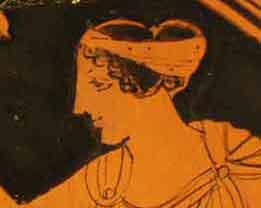
Sakkos a hairnet worn by women http://www.perseus.tufts.edu/cgi-bin/image?lookup=1992.06.0966 The sakkoi and the mitra were, on the contrary, made of close materials. The sakkoi covered the head entirely like a sack or bag; it was made of various materials, such as silk, byssus, and wool (comp. Aristoph. Thesm. 257). Sometimes, at least among the Romans, a bladder was used to answer the same purpose (Mart. viii.33.19). The mitra was a broad band of rich cloth of different colours, which was wound round the hair, and was worn in various ways. It was originally an Eastern head-dress, and may, therefore, be compared to the modern turban. It is sometimes spoken of as characteristic of the Phrygians (Herod. i.195, vii.62; Virg. Aen. ix.616, 617; Juv. iii.66). It was, however, also worn by the Greeks, and Polygnotus is said to have been the first who painted Greek women with mitrae (Plin. H.N. xxxv.9 s35). William Smith
Fillet a narrow piece of fabric which was worn around the head, for decorative effect. ( Gossman/Lewis Greek Fashion Terms)
Krobulos, a way of arranging the hair, a sort of topknot or crest formed by drawing all the hair to the crown and there confining it in a knot. This was old-fashioned for men in the time of Xenophon, but the hair was still worn so by children.
Tiara: crown like headdress of jewels
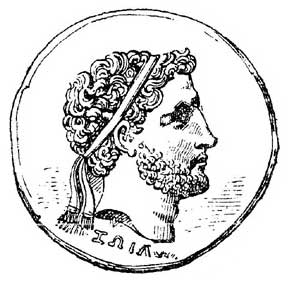
Coin of Perseus of Macedon, Perseus wearing a "taenia", tainia or diadema, used as a symbol for kings
Taenia http://www.perseus.tufts.edu/cgi-bin/image?lookup=1992.06.0966
Polos http://www.perseus.tufts.edu/cgi-bin/image?lookup=1992.05.0146
Sphendone http://www.perseus.tufts.edu/cgi-bin/image?lookup=1992.06.0967 On vases, however, we most frequently find the heads of females covered with a kind of band or a coif of net-work. Of these coiffures one was called sfendonh, which was a broad band across the forehead, sometimes made of metal, and sometimes of leather, adorned with gold William Smith

Exaltation fleur Louvre Ma701, Kekryphylon
Kekryphylon http://www.perseus.tufts.edu/cgi-bin/image?lookup=1992.06.0969 It was worn during the day as well as the night, and has continued in use from the most ancient times to the present day. It is mentioned by Homer (Il. xxii.469), and is still worn in Italy and Spain. These hair-nets were frequently made of gold-threads (Juv. ii.96; Petron. 67), sometimes of silk (Salmas. Exerc. ad Solin. p392), or the Elean byssus (Paus. vii.21 §7), and probably of other materials, which are not mentioned by ancient writers. The persons who made these nets were called kekrufaloplokoi (Pollux, vii.179). William Smith
Hairnet http://www.getty.edu/art/collections/objects/o24204.html
Stephanos, from stefo (put around), circlet, crown, chaplet, garland, of leaves, flowers, victory oak, olive, or wild celery wreath, or metal worn around the head and used as a festive ornament at dinner, or bestowed as a reward of merit. It was one of the institutions of Lycurgus that the Spartans should go into battle wearing wreaths; and the priest that officiated at the altar in sacrifice always wore a chaplet. The use of stephanoi among the Greeks, on both private and public occasions, was very common.
See also Coma or Come ( The hair of the head)
Hera in "pillbox" hat, as goddess of political authority
From SUDA
Boys before puberty in ancient Greece did not cut their hair short. Ἀκερσεκόμης: τὴν κόμην μὴ κειρόμενος. Not shearing the hair As an epithet of Phoebus (Homer, Iliad 20.39, the scholia to which are reflected here), not cutting the hair would imply eternal youth.
Jenkins/Williams 1985. I. Jenkins, D. Williams. Sprang hair nets: Their manufacture and use in Ancient Greece, in: American Journal of Archaeology 89 (1985). 411-418
white-ground tondo of kylix: dancing Maenad with leopard and thyrsus, hair tied back with a snake , Greek, attributed to Brygos, c. 490 BC
The Athenians were the first to lay aside their weapons, and to adopt an easier and more luxurious mode of life; indeed, it is only lately that their rich old men left off the luxury of wearing undergarments of linen, and fastening a knot of their hair with a tie of golden grasshoppers, a fashion which spread to their Ionian kindred and long prevailed among the old men there. Thucydides, First Book - The Peloponnesian War
Remarks: Since the archaic times long hair was a mark of the aristocrats.
koureion a ceremony (ritual of maturation) in which adolescent boys cut their hair and enter into one of the groups the citizen were organized (phatriae), after this ceremony following the annual festival of the Apatouria the boys were considered old enough to start their military education as an ephebe.
William Smith :
In the earliest times the Greeks wore their hair long,... This ancient practice was preserved by the Spartans for many centuries. The Spartan boys always had their hair cut quite short ... but as soon as they reached the age of puberty they let it grow long. They prided themselves upon their hair, calling it the cheapest of ornaments and before going to battle they combed and dressed it with especial care, in which act Leonidas and his followers were discovered by the Persian spy before the battle of Thermopylae. It seems that both Spartan men and women tied their hair in a knot over the crown of the head At a later time the Spartans abandoned this ancient custom, and wore their hair short...
The custom of the Athenians was different. They wore their hair long in childhood, and cut it off when they reached the age of puberty. The cutting off of the hair (“koureion” ceremony), which was always done when a boy became an ephebe was a solemn act, attended with religious ceremonies. A libation was first offered to Hercules, which was called oinisthtria ; and the hair after being cut off was dedicated to some deity, usually a river-god (Aeschyl. Choëph. 6; Paus. i.37 §2). It was a very ancient practice to repair to Delphi to perform this ceremony, and Theseus is said to have done so (Plut. Thes. 5; Theophr. Char. 21). The ephebi are always represented on works of art with their hair quite short, in which manner it was also worn by the Athletae (Lucian, Dial. Mer. 5). But when the Athenians passed into the age of manhood, they again let their hair grow. In ancient times at Athens the hair was rolled up into a kind of knot on the crown of the head; and fastened with golden clasps in the shape of grasshoppers. This fashion of wearing the hair, which was called krobuloi, had gone out just before the time of Thucydides (i.6); and what succeeded it in the male sex we do not know for certain.
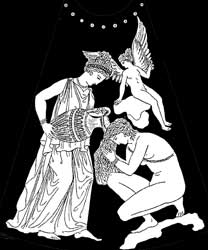
Hair Washing, The State Hermitage Museum, St. Petersburg, Russia

Melon head dress, Chiaramonti Inv1464
See also Beard (πώγων, γένειον, ὑπήνη)
HATS
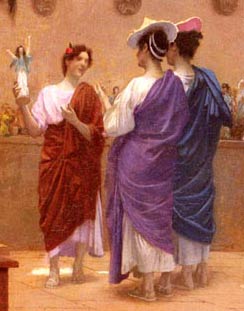
Part of a work of Jean-Léon Gérôme showing Greek women wrapped in himatia wearing sun hats (Tanagra hats with a conical crown). A reconstruction from Tanagra figurines produced mainly between 340-200 BC in Boeotia, a region north of Attica


Macedonian boy BM 1906.10-19.1
See Tanagra Terracotta figures
Alopeke (αλωπεκή ) a fox-skin cap , example can be seen on the Noth Frieze, XL block of the Parthenon, a horseman with a Thracian Alopeke
Calotte a close-fitting skull cap.
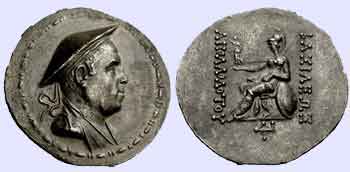
Coin showing the Greek-Bactrian King Apollodotus I wearing a kausia, with bead and reel border.
Kausia, a hat with a broad brim, which was made of felt and worn by the Macedonian kings. The Romans adopted it from the Macedonians (Plaut. Mil.Glor. iv.4.42, Pers.i.3.75; Antip. Thess. in Brunckii Anal. ii.111), and more especially the Emperor Caracalla, who used to imitate Alexander the Great in his costume. William Smith, A Dictionary of Greek and Roman Antiquities, John Murray, London, 1875.
Kyne Greek soldier's leather helmet

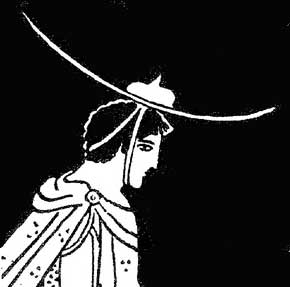
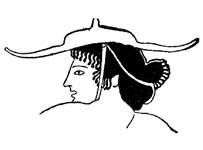
Petasos a large brimmed hat with a thin strap it could be worn hanging down the back (See also image below). The petasos is the first real hat invented by Greeks.
Meniskos (Μηνίσκος)(See the image of the Peplos Kore at the top of this page)
Phrygian Bonnet One of the most replicated styles of hat worn by the Greeks. This style has come back into fashion frequently. It was shaped in a softly conical shape, rather like a stocking cap, with a peak falling forward and with side pieces hanging down. ( Gossman/Lewis Greek Fashion Terms). The Bonnet was worn by the insurgents during the French Revolution A modern version , Also the Smurfs use a Phrygian Bonnet
Tanagra straw hat with tall conical crown seen on statues
Tholia women's straw hat wide and flat with a peaked crown: high, pointed hat with a brim
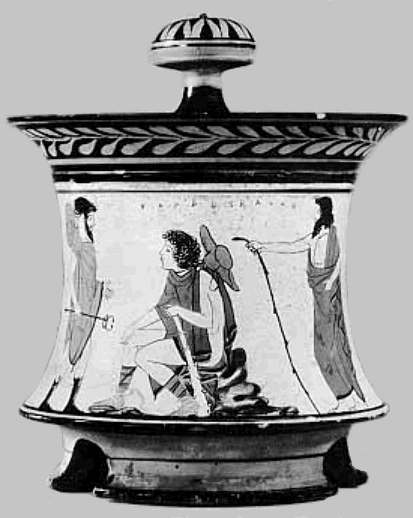
Greek with a chlamys or chlamya, a petasos and of course no underwear.
COSMETICS and Perfumes/ Καλλωπισμός
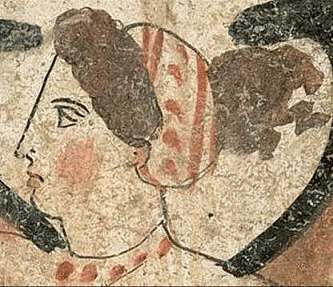

Greek Woman 4th century BC using probably rouge.. (Paestum)
Psimythion, (ψιμυθιον) (white lead color) one of the oldest paint pigments (basic lead carbonate, a mixture of lead carbonate and lead hydroxide, (PbCO3)2 Pb(OH)2).
Phykos, (root juice), a blush/rouge spread out over cheeks to give a more lively look
Red Ochre (Miltos), In Xenophon's Oikonomikos (10.5) Iskhomakhos tells Sokrates about a conversation he had with his new wife in which he dissuaded her from using cosmetics to make herself more attractive. In order to convince her of his viewpoint, he asks her to imagine her reaction to his coming to bed anointed with red ochre (miltos) and wearing eye make-up. She is suitably put off by the idea. Pat Hannah The Cosmetic Use of Red Ochre (Miltos)
Asbolos, (charcoal dust or soot), a black paint that was used to dye eyebrows

Pyxis is a box-shaped pottery with a lid and used for ointments and cosmetics.
In the News
Ancient Romans slapped on face cream
Perfumes
According to Pliny the Elder Cyprus was the earliest source of some of the most popular perfumes in the ancient world. Recently a perfume factory from 2000 BC was discovered. “Scientists have reconstituted 12 different perfumes from traces of scents found in dozens of clay bottles at the site. So far they have extracted essences of laurel, cinnamon and myrtle - all likely to have been derived from local plants, and then mixed with olive oil. The scale of the site and the presence of huge 500-litre oil storage jars suggests it was the centre of a prosperous export business” Info and Source
Oinochoe-chous (jug) depicting women perfuming clothes
| Ancient Greece
Science, Technology , Medicine , Warfare, , Biographies , Life , Cities/Places/Maps , Arts , Literature , Philosophy ,Olympics, Mythology , History , Images Medieval Greece / Byzantine Empire Science, Technology, Arts, , Warfare , Literature, Biographies, Icons, History Modern Greece Cities, Islands, Regions, Fauna/Flora ,Biographies , History , Warfare, Science/Technology, Literature, Music , Arts , Film/Actors , Sport , Fashion --- |

